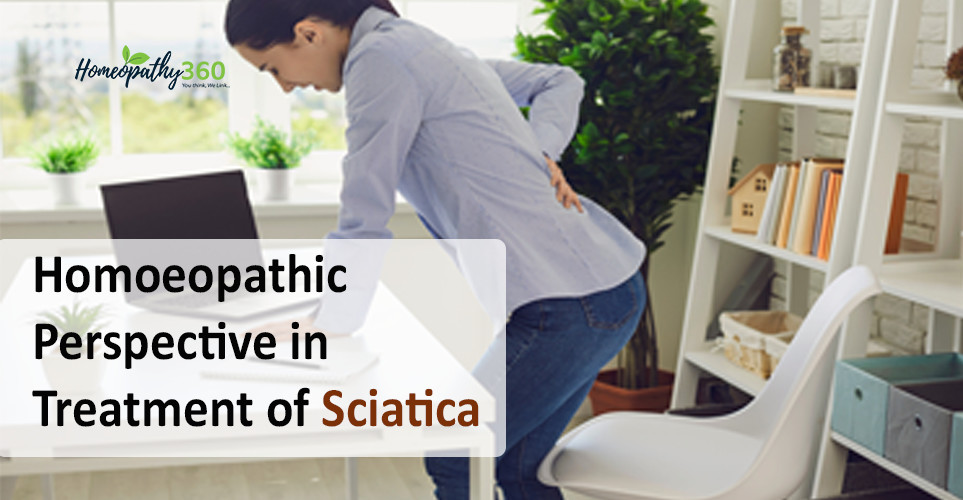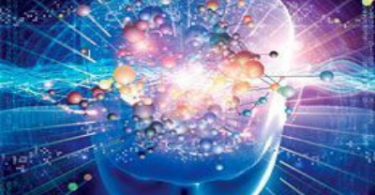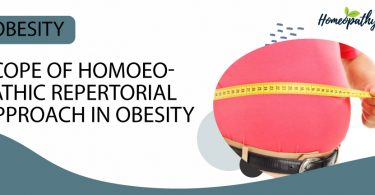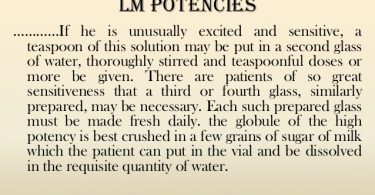
Abstract(1):
Sciatica is characterized by the severe pain in the leg along the course of sciatic nerve felt in the buttocks, at the back of thigh running down the outer side and back of leg and the outer border of foot and toe.
Keywords : Sciatica, Lumbar Radiculopathy, homeopathy
Introduction1,2:
Sciatica is a debilitating condition in which the patient experiences pain and/or paresthesia in the sciatic nerve distribution or an associated lumbosacral nerve root. The sciatic nerve is made up of the L4 to S2 nerve roots. Sciatica pain often is worsened with flexion of the lumbar spine, twisting, bending, or coughing.
The most common cause of sciatica is a herniated or bulging lumbar intervertebral disc also known as a ruptured or slipped disc – in which the gel-like center of an intervertebral disc of the spine sticks out through a tear in its outer ring (called the annulus). This slippage puts pressure on the nerve roots located just next to the disc.
In the elderly population, lumbar spinal stenosis may cause these symptoms as well.
Risk factors for sciatica include:
- age-related changes to the spine
- obesity, which can put extra pressure on the spine
- occupations where you twist the spine or pick up heavy loads
- prolonged sitting
- diabetes, which can increase the risk of nerve damage
Causes1,2 :
Common medical conditions that may cause sciatica include :
- A herniated lumbar disc
- Lumbar spinal stenosis
- Lumbar degenerative disc disease, general degenerative changes in vertebrae or discs
- Spondylolisthesis
- Muscle spasm and/or inflammation of the lumbar and/or pelvic muscles
- Sacroiliac joint dysfunction
Rarely, tumors, blood clots, or other conditions in the lower spine may cause sciatica.
Symptoms1,2 :
The symptoms of sciatica may range from infrequent and irritating to severe and debilitating. The symptoms depend on the specific spinal nerve root that is irritated and/or compressed at the origin of the sciatic nerve. One or more nerve roots may be affected together.
1. Moderate to severe pain in lower back, buttock and down your leg.
2. Numbness or weakness in your lower back, buttock, leg or feet.
3. Pain that worsens with movement; loss of movement.
4. “Pins and needles” feeling in your legs, toes or feet.
5. Loss of bowel and bladder control (due to cauda equina).
Treatment:
- Complete bed rest on hard bed during acute stage, which may be continued for 3-4 weeks. Prolonged bed rest is also recommended for patients with chronic problems.
- Supine position is best adopted but no rotation of the spine is allowed.
- Analgesics and local heat to relieve pain.
- Cases which do not respond to rest and medical treatment may require surgery after investigations of the cause.
Homoeopathic management for Sciatica3,4,5
- Ammonium Mur – sciatica is worse while sitting and is better on lying down. There is contraction in the back part of the thigh and calf area. The pain is shooting and tearing in nature. Shooting and tearing pain in tips of the toes. Generally the patient feels better in open air.
- Arsenic album – sciatica with burning pain in the lower back extending to legs and feet. Heaviness and weakness in limbs. Patient is very restless with nocturnal aggravation. Burning pain is relieved by heat and gets worse from cold and at night and cold and wet weather.
- Bryonia alba – remedy for sciatica that worsens with any motion, touch and in morning and is better by lying on painful side, pressure and by rest.
- Colocynthis – for left-sided sciatica. The pain starts in the lower back and radiates down the leg to toes. The pain may be drawing/tearing/ shooting in nature. Pressure application may provide relief. Lying on the left side and warm application also offers relief. Pain get worse by gentle touch.
- Gnaphalium Polycephalum – medicine for sciatica pain associated with numbness. Folding thighs towards the abdomen provides some relief. Gnaphalium Polycephalum is also prescribed in sciatica cases where pain is confined to the calves and feet.
- Hypericum perforatum – sciatic pain is attended with tingling, burning, or numbness in the affected leg. The spine is also very sensitive to the touch. Lancinating pain in the lower limbs and tips of the toes. Crawling in the feet. Pain is worse in cold, damp weather and on touch.
- Magnesia Phosphorica – for right-sided sciatica. The sciatica pain is darting , shooting or stitching in nature. Feet are very tender. Pain starts in the lower back and extends down the right hip, thigh, the hollow of knee and leg. Pressure or warm applications provides relief. In some cases, uncovering the lower limb worsen the pain.
- Plumbum metallicum – Pain in the muscles of thighs come in paroxysms. Stinging and tearing in limbs, twitching, tingling, numbness. Pain is worse at night and by motion and gets better by hard pressure and rubbing.
- Rhus Tox – Pain in the lumbosacral region, tearing down the thighs and numbness. Pain is usually worse in cold and damp weather and when lying on the right side and while sitting. It gets better with warmth, motion and lying on something hard. Night time is worse for the sciatica patient.
- Ruta Graveolens – Lumbosacral region is very painful. Spine feele bruised. Pain from the back extends down to hips and thighs. Pain is worse on lying down at night, in cold, wet weather. Backache is better by pressure and lying down on your back. Thighs pain on streching the limbs. Great restlessness.
- Silicea Terra – Pain from spine radiates to hips, legs and feet. Spine is very weak. Pain is worse in the morning, in cold damp weather, and lying on the left side is better because of warmth.
- Valeriana officinalis – for sciatica pain where pain is worse on standing and resting on the floor and is better by walking. There is heaviness in the limbs and the patient is very sensitive. Pain in heels when sitting.
Conclusion
Homoeopathy relies chiefly on the individual personality traits of the patient to make a diagnosis and treatment. Homoeopathy is predominantly an outpatient method of treatment, which fits with the preference of patients for treatment modalities that cause minimal disruption in their personal and professional lives. Homoeopathy is one of the most popular holistic systems of medicine. The selection of remedy is based upon the theory of individualization and symptoms similarity . As far as therapeutic medication is concerned; several well-proven remedies are available for Sciatica treatment that can be selected on the basis of cause, location, sensation, modalities and extension of the Sciatica.
References
1. Colledge NR, Walker BR, Ralston S. Davidson’s Principles and Practice of Medicine. 21st Edition. Edinburgh: Churchill Livingstone Elsevier; 2010’
2. Kasper DL, Fauci AS, Hauser SL, Longo DL, Jameson JL, Loscalzo J. Harrison’s principles of internal medicine 19/E (ebook). 19th ed. McGraw-Hill Education/Medical. 2015;1(2).
3. Allen HC. Keynotes Rearranged and Classified with Leading Symptoms of Materia Medica with Bowel Nosodes, B Jain Publisher (p) Ltd.; c2015, p 568.
4. Clarke JH. A Dictionary of Practical Materia Medica. New Delhi: B Jain Publisher Pvt Ltd; 2015.
5. Boericke W. Boericke’s New manual of Homoeopathic Materia Medica with Repertory. Third revised & augmented edition based on 9th ed. India: B. Jain Publishers; c2015.
About the Author:
1. Dr. Ashok Yadav , Head of Department, Department of Practice of Medicine, Dr. M.P.K. Homoeopathic Medical College, Hospital & Research Centre, Homoeopathy University, Jaipur, Rajasthan, India.
2. Dr. Virendra Chauhan, Asst Prof. Dept. Of Practice of Medicine (Hom.), Dr. M.P.K. Homoeopathic Medical College, Hospital and Research Center. Homoeopathy University, Jaipur, Rajasthan, India.
3. Dr. Aditee Sharma, MD scholar, Department of Practice of Medicine, Dr. MPK Homoeopathic Medical College Hospital & Research Centre, Homoeopathy University, Jaipur, Rajasthan, India.
4. Dr Pawan Choudhary, MD scholar, Department of Practice of Medicine, Dr. MPK Homoeopathic Medical College Hospital & Research Centre, Homoeopathy University, Jaipur, Rajasthan, India.
5. Dr. Sakshi Sharma, MD scholar, Department of Practice of Medicine, Dr. MPK Homoeopathic Medical College Hospital & Research Centre, Homoeopathy University, Jaipur, Rajasthan, India.





